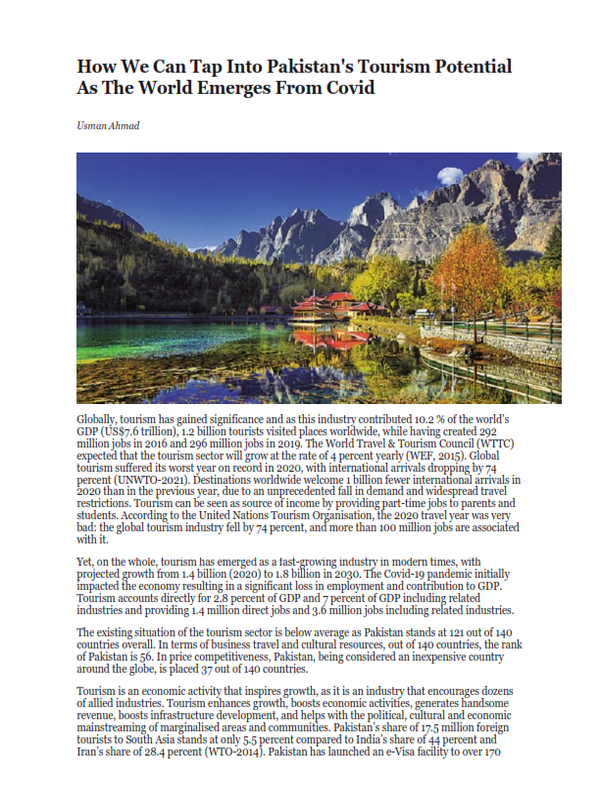
Pakistan Institute of Development Economics
- Home
Our Portals
MenuMenuMenuMenuMenuMenuMenu - ResearchMenuMenuMenuMenuMenuMenuMenu
- Discourse
- The PDR
- Our Researchers
- Academics
- Degree Verification
- Thesis Portal
- Our Portals
How We Can Tap Into Pakistan’s Tourism Potential As The World Emerges From Covid
“Keeping in view the better law-and-order situation and political will, it is predicted that by 2025, the tourism sector will contribute Rs.1 trillion to the country’s economy by tapping unexplored potential,” writes Usman Ahmad
Globally, tourism has gained significance and as this industry contributed 10.2 % of the world’s GDP (US$7.6 trillion), 1.2 billion tourists visited places worldwide, while having created 292 million jobs in 2016 and 296 million jobs in 2019. The World Travel & Tourism Council (WTTC) expected that the tourism sector will grow at the rate of 4 percent yearly (WEF, 2015). Global tourism suffered its worst year on record in 2020, with international arrivals dropping by 74 percent (UNWTO-2021). Destinations worldwide welcome 1 billion fewer international arrivals in 2020 than in the previous year, due to an unprecedented fall in demand and widespread travel restrictions. Tourism can be seen as source of income by providing part-time jobs to parents and students. According to the United Nations Tourism Organisation, the 2020 travel year was very bad: the global tourism industry fell by 74 percent, and more than 100 million jobs are associated with it.
Yet, on the whole, tourism has emerged as a fast-growing industry in modern times, with projected growth from 1.4 billion (2020) to 1.8 billion in 2030. The Covid-19 pandemic initially impacted the economy resulting in a significant loss in employment and contribution to GDP. Tourism accounts directly for 2.8 percent of GDP and 7 percent of GDP including related industries and providing 1.4 million direct jobs and 3.6 million jobs including related industries.
The existing situation of the tourism sector is below average as Pakistan stands at 121 out of 140 countries overall. In terms of business travel and cultural resources, out of 140 countries, the rank of Pakistan is 56. In price competitiveness, Pakistan, being considered an inexpensive country around the globe, is placed 37 out of 140 countries.
Tourism is an economic activity that inspires growth, as it is an industry that encourages dozens of allied industries. Tourism enhances growth, boosts economic activities, generates handsome revenue, boosts infrastructure development, and helps with the political, cultural and economic mainstreaming of marginalised areas and communities. Pakistan’s share of 17.5 million foreign tourists to South Asia stands at only 5.5 percent compared to India’s share of 44 percent and Iran’s share of 28.4 percent (WTO-2014). Pakistan has launched an e-Visa facility to over 170 countries to promote tourism and preparation of the National Tourism Strategy Action Plan (2020-2025). In 2019, Switzerland, which is half of the size of our Northern Areas, earned US $ 47 billion from tourism. For the same year, only 5.7 percent of the total economy of Pakistan was generated from travel & tourism in year 2019, which is far less as compared to other Asian countries. In 2016, travel and tourism contributed US $ 7.6 billion (2.7% of GDP), an increase of 5.1% (833.8 billion PKR) in 2017 and is expected to grow by 5.6 percent pa to PKR 1, 432.1billions of GDP by 2027 (WTTC, 2017). The direct contribution of travel and tourism in 2016 was 1.337 million jobs (2.3 percent of total employment), predicted to increase by 2.5 percent pa to 1.757 million jobs in 2027 (2.3 percent of total employment). As per the World Travel & Tourism Council report 2021, travel and tourism contributed $8.8 billion, approximately 2.9% of total GDP of Pakistan, in 2017. By 2019, the total GDP contribution of tourism to Pakistan was $15 billion, which accounts for 5.7% of the total GDP. However, due to the Covid-19 pandemic, this growth fell significantly in 2020, by nearly 25% or 4.4% of GDP. Similarly, jobs in the tourism industry fell 11.1% from 3.45 million in 2019 to 3.63 million in 2020.
Keeping in view the current prevailing better law and order situation and, above all, the will of the government, it is predicted that by 2025, the tourism sector will contribute Rs.1 trillion to the country’s economy by tapping unexplored potential. Pakistan was ranked the Top Holiday Destination for the year 2020 by the United States-based luxury and lifestyle publication Conde Nast Traveller.
Currently, Pakistan is not able to reap all the benefits of the tourism industry. The situation can be turned around by pursuing consistent policies likeL
- Ensuring safety of the tourists, via an improved law-and-order situation
- Making improvements in infrastructure, roads, airports and railways
- Government advertising for potential tourist spots using social media
- Private–public collaboration to net more investment
- Creating activities like the Dubai Safari in the Thar Desert or Cholistan. Another possibility could be a cultural train leaving from Islamabad while stopping at diverse cultural destinations of all Pakistan and ending at Quetta. Along the lines of the Kartarpur Corridor, Pakistan can also present the holy sites of the Buddhist tradition to East Asian and other visitors.



